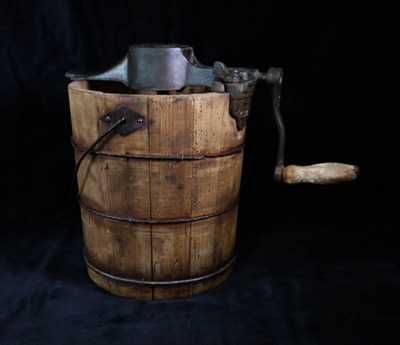Name/TitleIce cream freezer
About this objectIt consists of a tub, handle and bevel gear attachment and mixing mechanism suspended from the latter. The tub is made from eleven interlocking vertical sections of differing widths, held together by two horizontal wire strips, (another is missing) which are held in place by staples. One attachment for fitting the mixing canister remains at the top of the tub marked '870'. A wire handle is also attached. Two canvas strips are inside the tub, loose.
Ice was placed in the tub and thus froze the ice-cream mixture which was placed in the metal canister within the tub. This canister also contains a mixing mechanism for the cream. This specimen was found in the barn at the donor's farm. It was made by Shephard's in the USA, and probably dates from the 1880s or 1890s.
Bethan Huby, Research Volunteer:
Ice cream is made nowadays in factories on a mass scale, using electricity to power the mixers, in a variety of flavours, and readily available to purchase in supermarkets worldwide. However, in the 18th and 19th centuries, ice cream was made by hand and was a treat reserved for the elite; Queen Anne had England’s first dairy based ice cream in 1733 . George Washington and Thomas Jefferson were known to have regularly eaten ice cream in the late 18th century and ice cream was also served at James Madison’s Presidential inaugural ball in 1813.
Homemade ice cream was achieved by placing a bowl into a bucket of salt and ice and scraping the sides to remove the ice crystals. Natural ice was used and collected during winter, then stored in ice houses to be used in the warmer months. The production of ice cream was quickened by the invention of ice cream makers that operated paddles with a hand-crank to scrape the sides and turn the cream; this is how the first ice cream maker, patented in the 1840s worked.
The introduction of mechanical refrigeration in 1878 helped the wholesale industry to make and store ice cream; French Brothers’ Dairy Company in 1896 made ice cream in the traditional method, using ice and salt, but they stored their milk and finished product in refrigerators. The addition of refrigerators in the home in the 1920s saw a decline in small ice cream freezers in the home.
Ice cream became synonymous with summer events with large quantities sold by wholesalers in confectionary stores and ice cream saloons. Celebrations on the 4th of July included ice cream, with makers advertised in newspapers alongside various meats and firecrackers. This ice cream obsession was shared by the American public, but it was especially the children who were enchanted. Children could hand crank the ice cream mixture, and lick the stirrer once made, like licking the cake batter from a spoon; still a common childhood memory for many people.
Ice cream became a symbol of the American way of life; transported over with early colonists, eaten by their Founding Fathers, and at their Independence Day celebrations. In 1905, the annual production of ice cream was 4 million gallons, increased to 1.4 billion gallons by 2017 . This frozen treat was deemed so important that the US Military exported ice cream to overseas troops in World War Two, because it improved their morale and reminded them of home
Medium and MaterialsMade from wood and iron (tinned)
Inscription and MarksOn top of handle section is cast: "SHEPARD'S LIGHTNING, MADE IN USA, 201."
MeasurementsHeight 310 mm
diameter 220 mm
Object Typefreezer
Object numberSTMEA:A.5252
Copyright Licence![]() Attribution - Non-commercial (cc)
Attribution - Non-commercial (cc)



